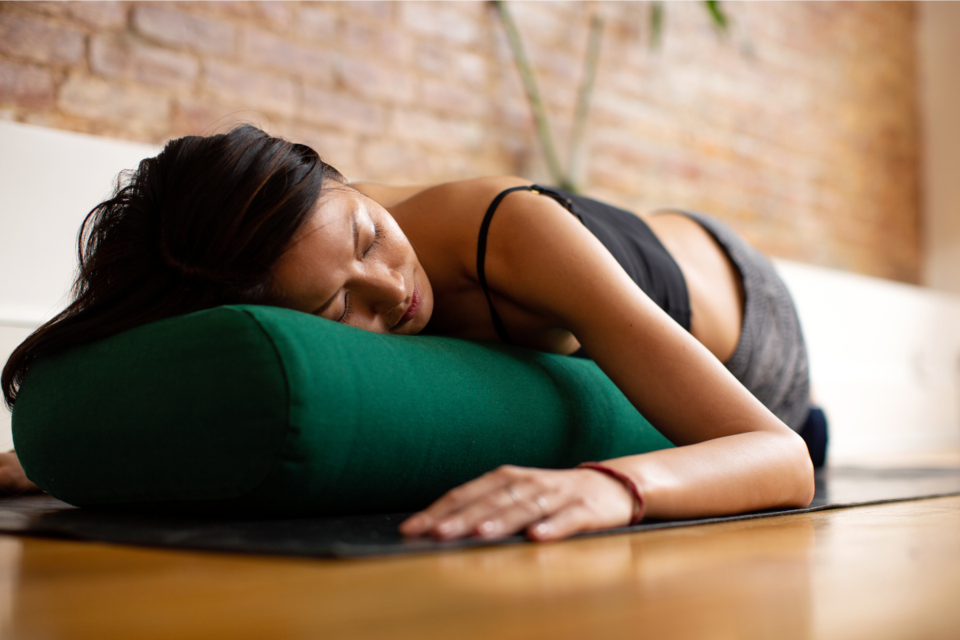If you’ve ever felt like your life is moving too fast and your body and mind just need a break, you’re not alone. Sometimes, what we really need isn’t a workout or a challenge, but a chance to completely slow down and let go. That’s where restorative yoga comes in: a gentle, slow-paced practice where the only goals are rest, recovery, and deep relaxation.
Restorative yoga is different from the more active types of yoga you might be familiar with. Instead of flowing through poses or working up a sweat, you settle into supported postures held for several minutes. The magic happens because your body is fully supported by things like bolsters, blankets, and blocks, so you don’t have to do any muscle work at all. This allows your nervous system to switch off the stress response and invite calm, healing, and ease.
What happens to your body in restorative yoga?
When we’re stressed, our body is stuck in what’s called the “fight or flight” mode: our heart races, muscles tense, and cortisol (the stress hormone) floods our system. Restorative yoga helps flip the switch to the “rest and digest” mode, where your heart rate slows down, your breathing becomes steady and deep, and your body starts to repair itself.
A big part of this happens through the vagus nerve, a kind of communication highway between your brain and body that helps calm your nervous system. Long-held, supported poses combined with mindful breathing gently stimulate this nerve, helping you feel more relaxed not just during your practice, but even after you leave the mat.
What makes restorative yoga special is how it trains your brain to relax deeply. While this practice feels great in the moment, it also helps lower inflammation, reduce anxiety, and improve sleep over time. Because you hold poses for so long, your body learns to tune inwards, noticing subtle sensations you usually miss. This body awareness is linked to better emotional health and resilience, giving you tools to manage stress more effectively.
What to expect in a restorative yoga class
A restorative yoga class moves at a glacial pace, and that’s the point. You might only move through four to six poses over the course of an hour. Each one is held for anywhere from five to twenty minutes, allowing your body plenty of time to unwind.
When you arrive, your teacher will likely guide you through gathering props such as blankets, bolsters, blocks, sometimes even eye pillows or sandbags. These are used to support your body in each pose so that your muscles don’t have to do any work at all. You won’t be stretching in the usual sense. Instead, the support encourages your body to soften and settle, gently inviting your nervous system to relax, without pushing or pulling.
You’ll spend most of the class on the floor. Movements are minimal, and transitions between poses are slow and mindful. Teachers often speak softly, offering cues for breathing, small adjustments, or ways to get more comfortable. It’s not unusual for there to be long stretches of silence. And while you’re always encouraged to stay awake and aware, many people drift into a dreamlike state—some even fall asleep.
Common restorative yoga poses
You’re probably already familiar with child’s pose, a posture that naturally brings the body inward. In restorative yoga, props are added to make this pose even more comforting. You’ll curl your torso over a bolster or folded blankets, with your arms resting however feels best. The support takes all the effort out of the posture, allowing your hips to gently open and your spine to lengthen without tension. The effect is deeply calming.
One of the most beloved poses in restorative yoga is legs up the wall. As simple as it sounds, this pose is powerful. You lie on your back and rest your legs vertically against a wall, with your hips optionally elevated by a bolster. It’s a gentle inversion that encourages blood to flow back toward the heart, reducing fatigue in the legs and calming the entire nervous system. After a long day, it feels like a full-body exhale.
Each pose is paired with slow, conscious breathing—often through the nose, sometimes with longer exhales to help settle the mind. This is where the deeper science of the practice begins to take effect. When you breathe slowly and your body is supported, your brain interprets this as a signal of safety. The parasympathetic nervous system kicks in, dialing down stress hormones, softening muscle tension, and easing mental chatter.
Who is restorative yoga for?
The great thing about restorative yoga is that it’s for everyone. Whether you’re dealing with illness, injury, stress, or just the exhaustion of daily life, it offers a gentle, accessible way to care for yourself. Even if you practice more intense forms of yoga or other workouts, restorative yoga can be the perfect balance, and a chance to recover and recharge.
How to bring restorative yoga into your life
You don’t need a fancy studio to get started. All you need are a few blankets or cushions and a quiet corner. Find a comfortable spot, set a timer, and try settling into supported poses like child’s pose or legs up the wall. Focus on breathing slowly and deeply, and give yourself permission to relax fully. Even just five or ten minutes can start to soothe your nervous system and calm your mind.




